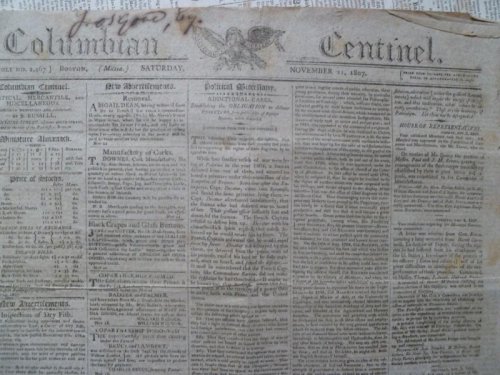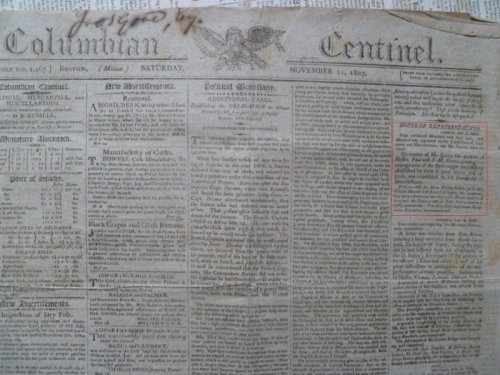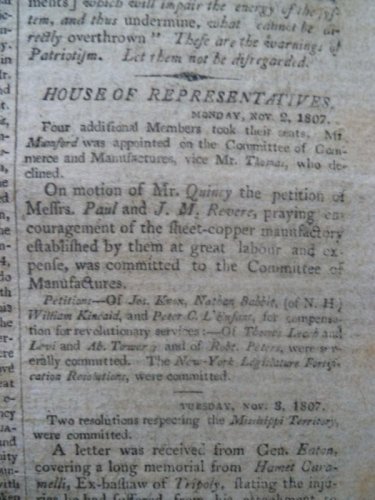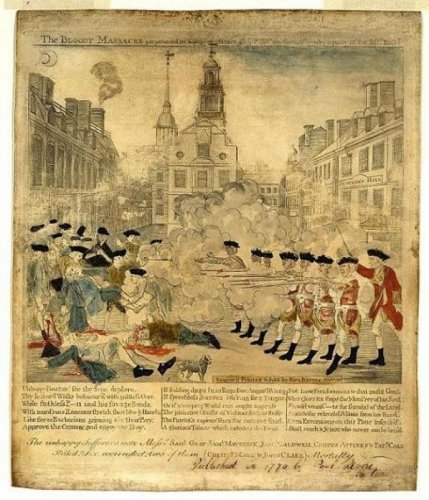Steve/sewell
Well-Known Member
- Joined
- Jan 23, 2010
- Messages
- 6,108
- Reaction score
- 5
- Points
- 0
In the November 21st 1807 edition of the Columbian Centinel a Boston Massachusetts we find a small front page ad from a small printing firm seeking the help financially of the the United States Government for their Sheet-Copper manufactury.You may have heard of this gentlemen before his name is Paul Revere.I love these old newspapers mostly I collect them for their glass related ads and signifcance but an added bonus is all of our countrys early history told the next day after it happened.This particular newspaper had no known ads that interested me just the price of $10.00 was attrative to me.You would be surprised at what you will stumble on to in these old papers.
A little history about the man behind the ad.In my humble opinion one of the top ten people in our countrys history.
Revere was likely born December,29th 1734, in Boston's North End.His father was a French Huguenot and his mother was Deborah Hichborn, daughter of a local artisan family. Paul Revere had eleven siblings. He was the third oldest child and the eldest surviving son. Revere's father, born Apollos Rivoire, came to Boston at the age of 13 and was apprenticed to the silversmith John Coney. By the time he married Deborah Hichborn, a member of a long-standing Boston family that owned a small shipping wharf, Rivoire had anglicized his name to Paul Revere. Paul was educated at the North Writing School and learned the art of gold and silversmithing from his father. When Paul was nineteen (and nearly finished with his apprenticeship) his father died, leaving Paul as the family's main source of income.
Two years later, in 1756, Revere volunteered to fight the French at Lake George, New York, where he was commissioned as a second lieutenant in the colonial artillery. Deborah probably assumed control of the business, while Paul and one of his younger brothers did the silver work. Revere fought briefly in the Seven Years War (French and Indian War), serving as a second lieutenant in an artillery regiment that attempted to take the French fort at Crown Point, in present day New York. Upon Revere returned to Boston after the war and assumed control of the silver shop in his own name.His silvershop was the cornerstone of his professional life for more than 40 years. As the master of his silversmith shop, Revere was responsible for both the workmanship and the quality of the metal alloy used. He employed numerous apprentices and journeymen to produce pieces ranging from simple spoons to magnificent full tea sets. His work, highly praised during his lifetime, is regarded as one of the outstanding achievements in American decorative arts.
Revere also supplemented his income with other work. During the economic depression before the Revolution, Revere began his work as a copper plate engraver. He produced illustrations for books and magazines, business cards, political cartoons, bookplates, a song book and bills of fare for taverns. He also advertised as a dentist from 1768 to 1775. He not only cleaned teeth, but also wired in false teeth carved from walrus ivory or animal teeth. Contrary to popular myth, he did not make George Washington's false teeth. Fabricating a full set of dentures was beyond his ability. One of the skills that distinguished him from other silversmiths was that he was not only an expert smith but also a skilled engraver and one of the few craftsmen who could complete a piece of silver, even to the engraved decoration. The daybooks of his shop that survived the years documents that the shop crafted more than 5,000 products. There were many small and affordable items such as buckles, buttons, rings and beads.
He was also a prominent Freemason as he rose through the ranks to become head master at his lodge.
Revere's silver work quickly gained attention in Boston; at the same time, he was befriending numerous political dissenters, including most closely Dr. Joseph Warren. On August 4, 1757, Paul Revere married Sarah Orne, who bore eight children, six of whom survived. During the 1760s, Revere produced a number of political engravings and advertised as a dentist, and became increasingly involved in the actions of the Sons of Liberty. In 1770, he purchased the house in North Square which is now open to the public. One of his most famous engravings was done in the wake of the Boston Massacre in March of 1770. It is not known whether Revere was present during the Massacre, though his detailed map of the bodies, meant to be used in the trial of the British soldiers held responsible, suggests that he had first-hand knowledge.His wife Sarah died in 1773, and on October 10 of that year Revere married Rachel Walker, with whom he would have five more surviving children.
Revere's political involvement arose through his connections with members of local organizations and his business patrons. As a member of the Masonic Lodge of St. Andrew, he was friendly with activists like James Otis and Dr. Joseph Warren. In the year before the Revolution, Revere gathered intelligence information by "watching the Movements of British Soldiers," as he wrote in an account of his ride. He was a courier for the Boston Committee of Correspondence and the Massachusetts Committee of Safety, riding express to the Continental Congress in Philadelphia. He also spread the word of the Boston Tea Party to New York and Philadelphia.
At 10 pm on the night of April 18, 1775, Revere received instructions from Dr. Joseph Warren to ride to Lexington to warn John Hancock and Samuel Adams of the British approach. The war erupted and Revere went on to serve as lieutenant colonel in the Massachusetts State Train of Artillery and commander of Castle Island in Boston Harbor. Revere and his troops saw little action at this post, but they did participate in minor expeditions to Newport, Rhode Island and Worcester, Mass. Revere's rather undistinguished military career ended with the failed Penobscot expedition.
Revere expanded his business interests in the years following the Revolution. He imported goods from England and ran a small hardware store until 1789. By 1788 he had opened a foundry which supplied bolts, spikes and nails for North End shipyards (including brass fittings for the U.S.S. Constitution), produced cannons and, after 1792, cast bells. One of his largest bells still rings in Boston's Kings Chapel.
Concerned that the United States had to import sheet copper from England, Revere opened the first copper rolling mill in North America in 1801. He provided copper sheeting for the hull of the U.S.S. Constitution and the dome of the new Massachusetts State House in 1803. Revere Copper and Brass, Inc., the descendent of Revere's rolling mill is best known for "Revereware" copper-bottomed pots and pans. Revereware is now, however, manufactured by another company.
Revere's community and social involvements were extensive. As stated earlier he was a Freemason from 1760 to 1809 and held several offices in St. Andrew's and Rising States Lodges as well as the Massachusetts Grand Lodge. A member of the Massachusetts Charitable Mechanics Association, Revere also served as the association's first president. Founded in 1794, the group was an organization of artisans, and small businessmen who sought to improve the conditions under which their peers worked and aided members in "distressed" circumstances.
In 1811, at the age of 76, Paul Revere retired and left his well-established copper business in the hand of his sons and grandsons. Revere seems to have remained healthy in his final years, despite the personal sorrow caused by the deaths of his wife Rachel and son Paul in 1813. Revere died of natural causes on May 10, 1818 at the age of 83, leaving five children, several grandchildren and great-grandchildren. The son of an immigrant artisan, not born to wealth or inheritance, Revere died a modestly well-to-do businessman and a popular local figure of some note. An obituary in the Boston Intelligence commented, "seldom has the tomb closed upon a life so honorable and useful." Paul Revere is buried in Boston's Granary Burying Ground. Here is a good link To Paul Reveres midnight ride.
http://www.paulreverehouse.org/ride/real.shtml

A little history about the man behind the ad.In my humble opinion one of the top ten people in our countrys history.
Revere was likely born December,29th 1734, in Boston's North End.His father was a French Huguenot and his mother was Deborah Hichborn, daughter of a local artisan family. Paul Revere had eleven siblings. He was the third oldest child and the eldest surviving son. Revere's father, born Apollos Rivoire, came to Boston at the age of 13 and was apprenticed to the silversmith John Coney. By the time he married Deborah Hichborn, a member of a long-standing Boston family that owned a small shipping wharf, Rivoire had anglicized his name to Paul Revere. Paul was educated at the North Writing School and learned the art of gold and silversmithing from his father. When Paul was nineteen (and nearly finished with his apprenticeship) his father died, leaving Paul as the family's main source of income.
Two years later, in 1756, Revere volunteered to fight the French at Lake George, New York, where he was commissioned as a second lieutenant in the colonial artillery. Deborah probably assumed control of the business, while Paul and one of his younger brothers did the silver work. Revere fought briefly in the Seven Years War (French and Indian War), serving as a second lieutenant in an artillery regiment that attempted to take the French fort at Crown Point, in present day New York. Upon Revere returned to Boston after the war and assumed control of the silver shop in his own name.His silvershop was the cornerstone of his professional life for more than 40 years. As the master of his silversmith shop, Revere was responsible for both the workmanship and the quality of the metal alloy used. He employed numerous apprentices and journeymen to produce pieces ranging from simple spoons to magnificent full tea sets. His work, highly praised during his lifetime, is regarded as one of the outstanding achievements in American decorative arts.
Revere also supplemented his income with other work. During the economic depression before the Revolution, Revere began his work as a copper plate engraver. He produced illustrations for books and magazines, business cards, political cartoons, bookplates, a song book and bills of fare for taverns. He also advertised as a dentist from 1768 to 1775. He not only cleaned teeth, but also wired in false teeth carved from walrus ivory or animal teeth. Contrary to popular myth, he did not make George Washington's false teeth. Fabricating a full set of dentures was beyond his ability. One of the skills that distinguished him from other silversmiths was that he was not only an expert smith but also a skilled engraver and one of the few craftsmen who could complete a piece of silver, even to the engraved decoration. The daybooks of his shop that survived the years documents that the shop crafted more than 5,000 products. There were many small and affordable items such as buckles, buttons, rings and beads.
He was also a prominent Freemason as he rose through the ranks to become head master at his lodge.
Revere's silver work quickly gained attention in Boston; at the same time, he was befriending numerous political dissenters, including most closely Dr. Joseph Warren. On August 4, 1757, Paul Revere married Sarah Orne, who bore eight children, six of whom survived. During the 1760s, Revere produced a number of political engravings and advertised as a dentist, and became increasingly involved in the actions of the Sons of Liberty. In 1770, he purchased the house in North Square which is now open to the public. One of his most famous engravings was done in the wake of the Boston Massacre in March of 1770. It is not known whether Revere was present during the Massacre, though his detailed map of the bodies, meant to be used in the trial of the British soldiers held responsible, suggests that he had first-hand knowledge.His wife Sarah died in 1773, and on October 10 of that year Revere married Rachel Walker, with whom he would have five more surviving children.
Revere's political involvement arose through his connections with members of local organizations and his business patrons. As a member of the Masonic Lodge of St. Andrew, he was friendly with activists like James Otis and Dr. Joseph Warren. In the year before the Revolution, Revere gathered intelligence information by "watching the Movements of British Soldiers," as he wrote in an account of his ride. He was a courier for the Boston Committee of Correspondence and the Massachusetts Committee of Safety, riding express to the Continental Congress in Philadelphia. He also spread the word of the Boston Tea Party to New York and Philadelphia.
At 10 pm on the night of April 18, 1775, Revere received instructions from Dr. Joseph Warren to ride to Lexington to warn John Hancock and Samuel Adams of the British approach. The war erupted and Revere went on to serve as lieutenant colonel in the Massachusetts State Train of Artillery and commander of Castle Island in Boston Harbor. Revere and his troops saw little action at this post, but they did participate in minor expeditions to Newport, Rhode Island and Worcester, Mass. Revere's rather undistinguished military career ended with the failed Penobscot expedition.
Revere expanded his business interests in the years following the Revolution. He imported goods from England and ran a small hardware store until 1789. By 1788 he had opened a foundry which supplied bolts, spikes and nails for North End shipyards (including brass fittings for the U.S.S. Constitution), produced cannons and, after 1792, cast bells. One of his largest bells still rings in Boston's Kings Chapel.
Concerned that the United States had to import sheet copper from England, Revere opened the first copper rolling mill in North America in 1801. He provided copper sheeting for the hull of the U.S.S. Constitution and the dome of the new Massachusetts State House in 1803. Revere Copper and Brass, Inc., the descendent of Revere's rolling mill is best known for "Revereware" copper-bottomed pots and pans. Revereware is now, however, manufactured by another company.
Revere's community and social involvements were extensive. As stated earlier he was a Freemason from 1760 to 1809 and held several offices in St. Andrew's and Rising States Lodges as well as the Massachusetts Grand Lodge. A member of the Massachusetts Charitable Mechanics Association, Revere also served as the association's first president. Founded in 1794, the group was an organization of artisans, and small businessmen who sought to improve the conditions under which their peers worked and aided members in "distressed" circumstances.
In 1811, at the age of 76, Paul Revere retired and left his well-established copper business in the hand of his sons and grandsons. Revere seems to have remained healthy in his final years, despite the personal sorrow caused by the deaths of his wife Rachel and son Paul in 1813. Revere died of natural causes on May 10, 1818 at the age of 83, leaving five children, several grandchildren and great-grandchildren. The son of an immigrant artisan, not born to wealth or inheritance, Revere died a modestly well-to-do businessman and a popular local figure of some note. An obituary in the Boston Intelligence commented, "seldom has the tomb closed upon a life so honorable and useful." Paul Revere is buried in Boston's Granary Burying Ground. Here is a good link To Paul Reveres midnight ride.
http://www.paulreverehouse.org/ride/real.shtml








